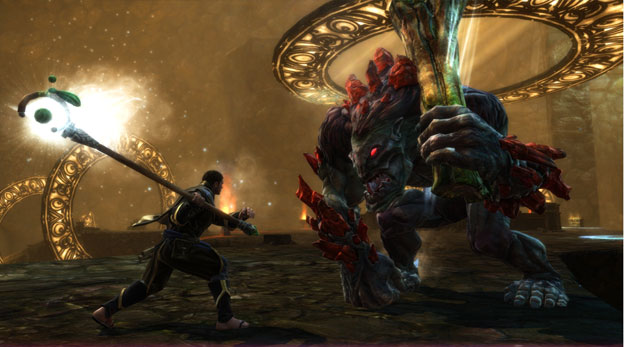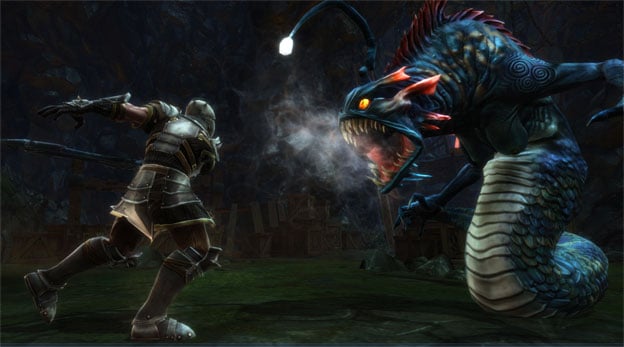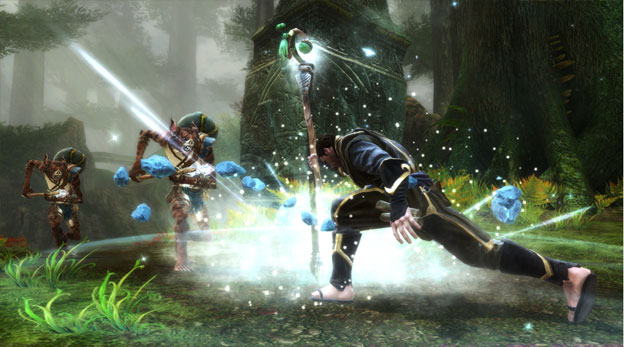In A Kingdom
There was a disturbing period some years ago, in the Halcyon Days of World of Warcraft, when much of the video game industry seemed to have collectively decided that MMOs were licenses to print money, while single-player RPGs were on the way out. So a great many studios invested great many years (in industry terms) to create a great many MMOs, most of which failed. At the same time, companies like BioWare invested in new single-player RPG franchises like Mass Effect, which proceeded to make a great deal of money.
This lesson was not lost on Electronic Arts, which announced Kingdoms of Amalur: Reckoning in the summer of last year. Creating a big gaming hit these days demands big talent and big attention-getting brand names, a requirement that Amalur fulfills by promising a setting created by best-selling fantasy author R.A. Salvator and famed graphic designer Todd McFarlane. If you were a teenager in the 90s, or simply wish you’d been around for the heyday of Spawn and Drizzt Do’Urden , this is a combination of names that is pure nerd catnip.

In Kingdoms of Amalur, you play a character called the Fateless One who dies in a great battle and is mysteriously revived by an artifact called the Well of Souls. As the Fateless One, you have the ability to begin as a blank slate and define yourself through choices you make about how to level up, defeat enemies, and resolve quests. The game’s main quest involves an invading force called the Tuatha who were initially responsible for your death, but Kingdoms of Amalur clearly isn’t designed to be a game that’s all about the main quest. Amalur includes literally hundreds of side quests, some of which cannot be accessed until after a player has completed the main quest and entered post-game.
Kingdoms of Amalur is a game primarily about exploring and making choices. Gameplay is heavily focused on sending the Fateless One out into the world to explore new areas, and once you’ve visited an area, you can fast travel back to it. As you travel across the world, you’ll come across different major cities with their own governments, residents, and features. NPCs operate according to daily schedules, traveling to fixed points throughout the world at different times of in-game day. As the Fateless One, you can do whatever you like, from playing the hero to running around pickpocketing everyone until you’re thrown in jail.

Combat in Kingdoms of Amalur tries to blend the seamless interface of action games with the solid foundation of stat-based advancement typical to RPGs. Each character can carry two different weapons (or a weapon and a shield) tethered to a different button. Players can execute flashy fighting moves by simply tapping buttons. How effective your moves are determine whether or not you can do things like inflict hit-stun on enemies, which means the game becomes genuinely easier when you fight level-appropriate enemies. Every player can also unlock spell-like abilities to play with from a distance, too. Combat in Kingdoms of Amalur is beautiful and kinetic, regardless of how you’ve designed your character through the game’s point-buy advancement system.

Kingdoms of Amalur is certainly a beautiful game, though it’s worth noting that most trailers and other visual media now focus on the Xbox 360 version of the game. It’s hard to say whether the visual fidelity of that version is going to translate to the PS3 or PC, as PC gamers especially will expect higher resolutions and even shinier animations.
Customization is the name of the game when it comes to character creation, as players can craft either a male or female hero from one of four races, with one of five patron deities (or none at all), combining skills from three different trees to determine their character’s abilities. Certain combinations of skills unlock Destinies, effectively class specializations that help a player be even better at whatever way he or she likes to play the game.
It’s worth noting that McFarlane and Salvatore aren’t the only star talent working on Kingdoms of Amalur: Reckoning. The game’s executive designer is Ken Rolston, the lead designer of Elder Scrolls III: Morrowind and Elder Scrolls IV: Oblivion. Any player who has enjoyed the freedom and complexity of those games should probably take an interest in Kingdoms of Amalur: Reckoning, which is clearly angling to present the same sort of depth in a way that’s more visually spectacular and visceral. If Amalur achieves any sort of success at that lofty goal, it’ll be a game to remember.
Game Features:
